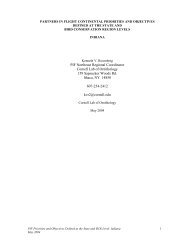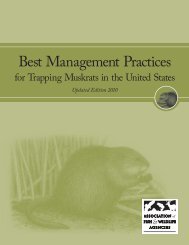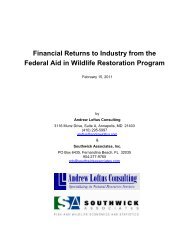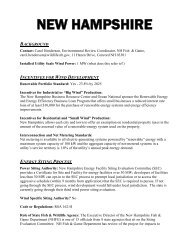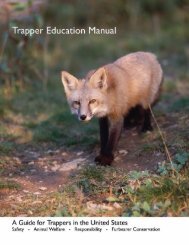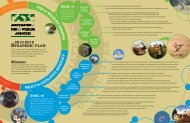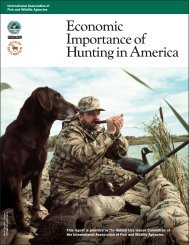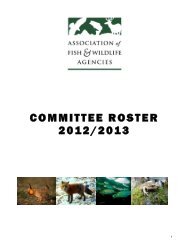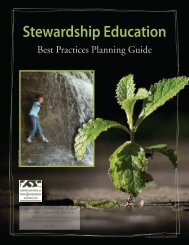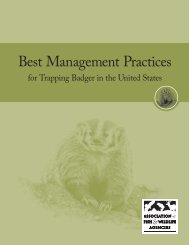Modern Snares for Capturing Mammals: - Association of Fish and ...
Modern Snares for Capturing Mammals: - Association of Fish and ...
Modern Snares for Capturing Mammals: - Association of Fish and ...
- No tags were found...
Create successful ePaper yourself
Turn your PDF publications into a flip-book with our unique Google optimized e-Paper software.
multiple variables must be considered when deploying a snare or designing a snare regulation <strong>for</strong>a particular outcome. Because one snare has a feature with greater killing potential thananother does not mean that one will kill an animal <strong>and</strong> the other will live-restrain. Consideringboth snare design <strong>and</strong> the manner in which the snare is deployed, multiple features may benecessary to achieve the desired outcome, <strong>and</strong> there are likely multiple configurations that maybe used to achieve the same outcome. Appropriate configurations vary depending on desiredoutcome, species <strong>of</strong> interest, location, user preference, <strong>and</strong> selectivity concerns.SelectivitySelectivity can be defined in different contexts. First, one can consider single-species selectivityas the ability <strong>of</strong> a snare to capture only one species. Secondly, one can consider selectivity <strong>for</strong> asuite <strong>of</strong> species that may be legally captured at a given time <strong>and</strong> place. The most importantaspect <strong>of</strong> ensuring desired selectivity is to remain vigilant <strong>for</strong> the presence <strong>of</strong> animals in the areathat are to be avoided. One should always consider potential selectivity when decidingwhether to increase or decrease the killing potential <strong>of</strong> a snare. Following is a list <strong>of</strong> factorsthat may be useful <strong>for</strong> influencing selectivity.‣ Loop size – while many trappers have preferred loop sizes <strong>for</strong> capturing a particularspecies, there is likely a range <strong>of</strong> loop sizes that may work equally as well <strong>for</strong> a givenspecies. Modifying loop size may still allow a desired animal to be captured, whileminimizing unintended capture. Loop size may be useful <strong>for</strong> minimizing capture <strong>of</strong>animals either larger or smaller than the intended species. For example, using thesmallest loop size necessary to capture a fox or coyote may reduce the risk <strong>of</strong> capturing awolf. Conversely, using the largest loop size possible to capture a beaver may minimizethe risk <strong>of</strong> capturing an otter. The greater the difference in size <strong>of</strong> animals, the greater theability to be selective.‣ Height <strong>of</strong> the loop from the ground – as with loop size, there is likely a range <strong>of</strong>acceptable distances the loop can be positioned above the ground <strong>and</strong> still capture aparticular species. Within this acceptable range, the snare loop should be positioned at alevel most apt to minimize risk <strong>of</strong> capture <strong>for</strong> other animals to be avoided. Loop heightmay be useful <strong>for</strong> minimizing capture <strong>of</strong> animals either larger or smaller than the desiredspecies. Raising a loop may allow smaller animals to pass under, while lowering it mayallow a larger animal to step over, or the loop may simply ‘brush’ <strong>of</strong>f the chest or leg <strong>of</strong> alarger animal. Lowering it too much, however, could result in capture <strong>of</strong> a larger animalby the leg if the animal does not jump over.‣ ‘Guide sticks’ - various natural or unnatural material may help guide the desired animalthrough the snare, <strong>and</strong>/or guide another animal over, under, or around the snare. Theplacement AND size or rigidity <strong>of</strong> the guide can influence animal behavior, <strong>and</strong> shouldboth be considered. For example, a large ‘jump stick’ placed too high, with the snareunderneath, may allow or encourage a deer to go under the stick <strong>and</strong> get caught, ratherthan jumping over the stick. Conversely, if the guide stick were small enough <strong>and</strong> notrigid (or if no guide stick was used), a fox or coyote may go through the snare <strong>and</strong> get19Ver. 1.0



